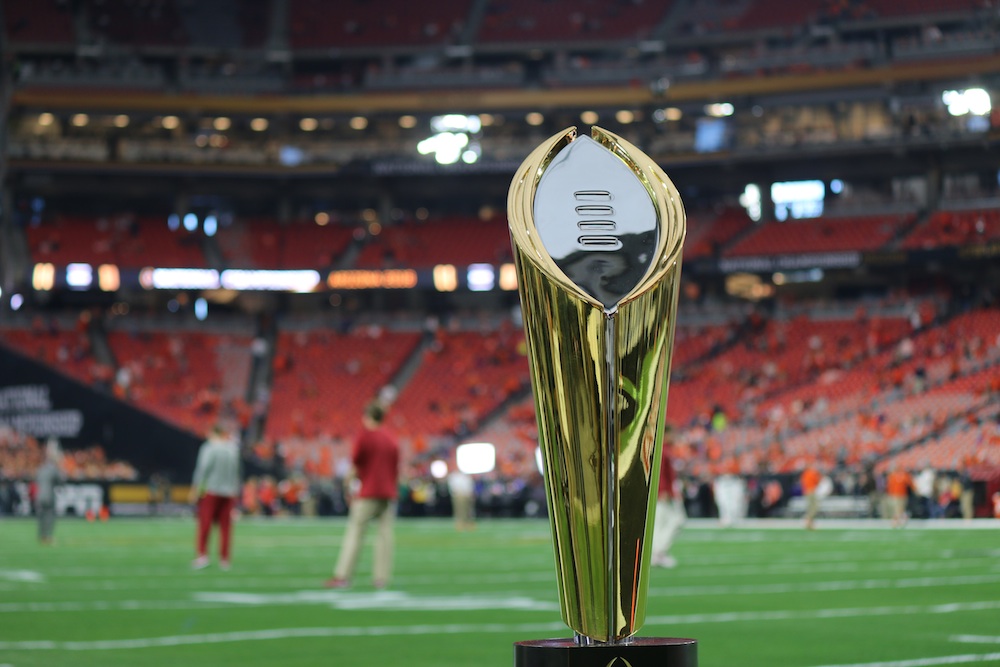The FBS conferences and Notre Dame agreed on Friday to continue the College Football Playoff beyond the 2025 season, signing a memorandum of understanding that paves the way for key details to be finalized in the coming days and weeks.
The memorandum, first reported by ESPN, doesn’t include a format for qualification or a specific number of participants, although a 14-team event is viewed as the most likely outcome.
But crucially, it binds the bickering conferences together contractually in a manner that should lead to the CFP signing a six-year media rights deal with ESPN.
“It has been a process,” a source said.
It has, indeed.
The 10 FBS conferences and Notre Dame agreed 18 months ago to expand the playoff from four teams to 12, but only for the 2024 and 2025 seasons — the final two years of the current media deal with ESPN.
Beyond that timeframe, the playoff existed in concept only. For the 2026 season and beyond, there was no competitive format, no governance structure, no revenue model and no media agreement for a postseason event.
There was, however, the perceived threat of the Big Ten and SEC breaking off and creating their own playoff, excluding the ACC, Big 12 and Group of Five leagues.
The Pac-12’s collapse and subsequent consolidation of power by the Big Two created a series of tense negotiations. At one point, according to a Yahoo report, the Big Ten and SEC pushed for their champions to receive guaranteed byes in the opening round, regardless of in-season performance.
(Thankfully, that preposterous notion encountered stiff resistance and vanished into the ether.)
Despite all the leverage plays and internal disputes, the conferences took a major step Friday with the memorandum of understanding, which is expected to lead to a six-year media deal with ESPN that will generate $1.3 billion annually.
However, in a break from the current process, the revenue distribution model for 2026 and beyond reportedly will tilt heavily toward the Big Ten and SEC. And it won’t include performance-based payouts.
Instead, all revenue will be distributed to the conferences according to a predetermined arrangement that assigns approximately 60 percent of the total revenue to Big Two, according to Yahoo.
For the Pac-12 schools headed into the Big Ten, the deal will prove ridiculously lucrative. The schools headed into the Big 12 and ACC will receive a nice uplift from their current CFP payments, but the checks won’t come close to matching the Big Ten payouts:
— USC, UCLA, Oregon and Washington can each expect approximately $21 million annually, according to ESPN — a four-fold increase from their current CFP revenue.
— The ACC-bound schools, Stanford and Cal, are expected to collect about $13 million each over the course of the contract.
— Meanwhile, Utah, Colorado, ASU and Arizona will receive about $12 million annually in the Big 12.
Over the course of the six-year contract cycle, that disparity will be immense:
The Big Ten schools will receive about $48 million more than the ACC schools and $54 million more than the Big 12 members. Such is the bifurcated world of college football created in the wake of the Pac-12’s collapse.
Four of the Pac-12 schools are entering their new leagues at discounted revenue shares: Oregon and Washington are set to receive about half-shares of the Big Ten’s media rights revenue, while Stanford and Cal are set for 30-percent shares of the ACC’s distribution.
However, those discounted revenue shares apply only to the regular-season broadcast agreements with each league’s media partners, not to postseason revenue.
Oregon, Washington, Stanford and Cal are expected to receive full shares of the CFP and NCAA Tournament revenue generated by their new conferences.
What of Washington State and Oregon State, the two schools left behind in the realignment game?
Their CFP situation is decidedly, but predictably, suboptimal.
The Cougars and Beavers must either join a conference by 2026, the start of the new playoff cycle, or rebuild the Pac-12. Either way, their league will be treated as a member of the Group of Five with annual CFP distributions of $1.8 million per school, according to ESPN.
ESPN was the first to report on the CFP’s expected $1.3 billion annual agreement with ESPN.
*** Send suggestions, comments and tips (confidentiality guaranteed) to pac12hotline@bayareanewsgroup.
*** Follow me on Twitter/X: @WilnerHotline
*** Pac-12 Hotline is not endorsed or sponsored by the Pac-12 Conference, and the views expressed herein do not necessarily reflect the views of the Conference.
Related posts:

(AP Photo/Andy Nelson)
Wilner Hotline: Ducks Get Spot They Wanted in College Football Playoff Rankings College Football Playoff rankings: Half the Pac-12 makes the cut with Washington, Oregon leading the way
College Football Playoff rankings: Half the Pac-12 makes the cut with Washington, Oregon leading the way 
Harry, the Washington Huskies mascot. (AP Photo/Ted S. Warren)
CFP rankings: Washington gains, Utah fades as Pac-12 places four teams in the committee’s top-25 Wilner – College Football Playoff: Schulz’s pitch for WSU and OSU, communication woes, SEC and Big Ten muscle and a murky future
Wilner – College Football Playoff: Schulz’s pitch for WSU and OSU, communication woes, SEC and Big Ten muscle and a murky future